Speaking of Hollywood’s favorite parlor game, I’d say right now that Tom Cruise is against the ropes and has a cut over his left eye, and that the industry crowd is starting to get a little bit excited at the possibility of seeing him hit the canvas, or at least watching him get slugged so many times he goes all wobbly in the knees. And yet Mission Impossible III (Paramount, 5.5) is paradoxically hanging in there , if for no other reason than the fact that people are hot for Phillip Seymour Hoffman‘ s bad-guy performance and, to a lesser extent, are up for what might happen with J.J. Abrams at the helm.
I missed this when it
I missed this when it went up last Wednesday, but Steve Berry does a this-and-that column for the Columbus Dispatch, and the 4.12 edition has the following Tom Cruise items: (a) a “Quote of the Day” in which a “Paramount Pictures insider” comments about an “audience reaction” to a Mission: Impossible III test screening, to wit: “There’s a scene where Tom (Cruise) gets beaten up pretty badly. And the test audience clapped…it was kind of weird“; and (b) “In a new poll at Parade.com, 84 percent of respondents blame the media for the negative publicity that Tom Cruise has received during the year since he began squiring Katie Holmes.” Don’t these items kind of argue with each other a bit? And what’s the origin of the alleged test screening story? Why didn’t Berry say when and where it allegedly happened, and who reported the comments of the alleged “Paramount Pictures insider”?
This is among the most
This is among the most Quixotic and futile things I’ve ever said in this column, but I genuinely believe there are metaphors of rot and doom and a swirling toiled-bowl fate contained in the popularity of the Scary Movie series, with the latest permutation having made just over $40 million this weekend. I know what I sound like in saying this, but will somebody who’s seen this latest bucket-of-urine, dumb-ass David Zucker movie please explain what it says about the kids going to see it that betokens any interior traits other than smugness, intellectual sloth and a profound aversion to anything the least bit exotic? What is a Scary Movie experience, sight unseen, other than an iron-clad guarantee that (a) you’ll be made to laugh or snicker every so often, (b) the movie will keep the subject matter in a totally safe, utterly familiar, channel-surfing vein and (c) it will throw audiences absolutely no curve balls whatsoever? More than anything else, Scary movies promise sameness and safety. If that doesn’t give you concern about where a lot of younger people are at these days then I don’t know what. Living in a membrane of smugness, material arrogance, and intellectual laziness is as much of a social malady as heroin, speed or alchohol addiction. They all indicate an attitude that says, “Leave us alone, dude…have a tub of popcorn and chill…we don’t know want to know.” I don’t know anything one way or the other, but I wonder what percentage of the kids who went to see Scary Movie 4 this weekend have personal discipline issues? Or have parents who drive big fat SUVs? I wonder what percentage of these kids are likely to see Al Gore’s An Inconvenient Truth when it opens in May? Two percent? One percent? Less? Everyone seeing Sofia Coppola’s Marie Antoinette next fall will be asked to consider the parallels between the arrogant, insulated attitudes of those living in the rarified environs of the palace of Versailles in the 1780s and those rolling in affluence today and the faux– Paris Hilton attitudes and personalities that always arise from this. Most people who see Coppola’s film are going to wave such thoughts away (if the parallels in fact occur to them), and you know who will be the first in this group to do so.
"I wrote a story last
“I wrote a story last summer [for the Toronto Star] about Tom Cruise that sparked a lot of email and walk-up conversations from women. Every single one of them, young and old, said they no longer liked Cruise. Many expressed the belief that he’d gone crazy. It was surprising to me how firm and how consistent they were in their opinion. I’ve talked to many women since, and their view of Cruise hasn’t mellowed one iota. He’s damaged goods as far as women go, while men never had that much time for him anyway. I find off-the-cuff reactions from people to be a much better judge of things like this than so-called experts or bogus surveys.
It’s that magical thing called ‘buzz,’ and it cuts both ways.
It’s going to be very interesting to see how M:I:3 does. It will have to attract a sizeable number of women — those guys all need dates — if it is going to do socko numbers.” — Peter Howell, critic and feature writer, Toronto Star
So what's the deal with
So what’s the deal with the extremely low profile apparently being sought by the makers and promoters of The Celestine Prophecy (Celestine Films), which is opening on 4.19 in San Francisco, and then in Seattle, Austin, Boulder, Berkeley and other mid-size cities later in the month? Based on James Redfield‘s famous best-seller, directed by Armand Mastroianni and costarring some good and respectable actors (Matthew Settle, Thomas Kretschmann, Sarah Wayne Callies, Annabeth Gish, Hector Elizondo, Joaquim de Almeida, Jurgen Prochnow), Celestine is a film about spiritual matters, to go by the trailer. It may be a piece of shit, but you’d think it would appeal to the people who liked What The Bleep Do We Know?. It’s not a hardcore born-again or Jesus flick in the Passion of the Christ vein, or even one about conventional faith or religion, but it’s clearly one of the many films coming out this year that are aimed at spiritually-minded moviegoers. And yet it wasn’t even mentioned in Scott Bowles‘ 4.14 USA Today piece about these films, nor was it mentioned in the sidebar that listed all the spiritual-religious films opening this year. Publicist Corinne Bourdeau of 360 Degree Communications says that a specal Celestine Prophecy screening will happen in Los Angeles on May 2nd, and that film will eventually play in New York. She says that “quite a few distributors wanted it but we wanted to go a non-traditional route,” meaning, in part, that “we haven’t reached out to reviewers.” The likely translation is that they know they’ve got a movie that’s going to get creamed by the big guns so they’ve decided to play to all the New Agers out there and, for now, bypass mainstream entertainment journalists and the the usual New York/Los Angeles launch strategy. Bordeau says the film is “going to speak to a broader audience” than the kind who usually read the New York Times or the trades or smarty-pants online columnists like myself. Celestine had a showing not too long ago in Los Angeles, she says, at the Agape International Spiritual Center in Culver City. This smells like a huge problem movie because even if you’re looking to reach people outside of the L.A.-N.Y. axis there’s no downside to opening in those cities unless (a) you’re broke or (b) there’s a likelihood your film is going to get critically butchered. I’m interested in this film because I know Settle, having sat down with him for a long chat once in ’04 at the Farmer’s Market about a short film I’d written.
"There have been three actors
“There have been three actors in Hollywood history that I can think of …Douglas Fairbanks, Burt Lancaster and Jackie Chan…who’ve done their own stunts, but they all had either a natural facility or training of some kind. I think that for Tom Cruise to announce that he’s doing his own stunts on Mission: Impossible 3….for a movie star of his calibre to do this, that can only come from a wild insecurity on his part.” — “name” guy who likes anonymity
This sound file is taken
This sound file is taken from the opening five or six minutes of HBO’s Too Hot Not to Handle, a global warming doc that will debut at 7 pm on 4.22 — “Earth Day.” It’s smart, absorbing…a very thorough rundown explaining how bad things have been getting, and how much worse they’ll get if we don’t do something about C02 emissions and greenhouse gases.
Mel Gibson's Apocalypto (Touchstone), an
Mel Gibson‘s Apocalypto (Touchstone), an ancient-history metaphor piece about a civilization destroying itself, has abandoned its August 4 release date and will now open on December 8. So either Gibson and Disney distributors have decided Apocalypto has year-end awards potential, or they didn’t like the idea of opening in the same late-summer period as Oliver Stone‘s World Trade Center and Clint Eastwood‘s Flags of our Fathers, or they decided they need a lot more time to get it ready.
I guess I misheard that
I guess I misheard that insider’s analogy between the Chicago Tribune‘s first-string film critic Michael Phillips and the recently deposed (i.e., downshifted to second-tier position) Michael Wilmington, so let’s try again. Phillips “is indeed an elegant writer, but I don’t think he and Wilmington are coming from the same aesthetic place. Wilmington runs hot and enthusiastic. Phillips runs cool and measured . Wilmington has lived and died for flickering lights in dark rooms his whole life. Phillips is more detached and analytical and a converted theater critic, albeit one with previous experience with movies as well, and is therefore more likely to reference real life than a Renoir film .”
Scary Movie 4 is estimated
Scary Movie 4 is estimated to do around $44,379,000 for the weekend, or $12,320 per print. Seriously…what does it say about American culture that this dumb parody film did as well as it did? How unhip do you have to be to really enjoy this? Ice Age: The Meltdown is off 41% from last weekend and estimated to earn $19,059,000. Benchwarmers is down 50% for a $9,797,000 haul. The reportedly very expensive Disney animated film The Wild, directed by Steve “Spaz” Williams, is a fourth-place disaster…$9,094,000 at $3180 a print. Take The Lead is down 38% for earnings of $7,490,000. Inside Man is being projected to bring in $6,505,000, off 29%. Lucky Number Slevin , a very tedious film, is down 30% and earning $4,508,000 for the weekend. Thank You for Smoking added 705 situations for a total of 1015, and will take in about $4,435,000.
Gotta Have It
Gotta Have It
I finally finished reading I Wake Up Screening: What To Do Once You’ve Made That Movie (Watson-Guptill) last week, and it’s one of the most easily processed, best written, most thoroughly sourced books ever written about how to get your indie movie seen (and maybe even distributed!) once it’s more or less finished.
I’m not going all kiss-ass on this book because I’m friendly with its authors, critic- journo John Anderson and Warner Independent marketing exec Laura Kim, or because I know just about every distribution exec, producer’s rep, indie publicist, film festival director, critic and entertainment journalist they’ve quoted.

Park City’s Main Street during the ’04 Sundance Film Festival
I’m saying this because it’s a sharp, cleanly written, well-organized thing, and because it contains lessons that I know are wise and based on hard experience, and because I’ve never read anything of its type quite as good. Really.
L.A. Times critic Kenneth Turan, Magnolia Pictures’ Eamonn Bowles, filmmakers Bill Condon and Kirby Dick, Picturehouse’s Bob Berney, New York Times critic Manohla Dargis, Cinetic’s John Sloss, exhibitor Gregg Leammle, N.Y. Times reporter Sharon Waxman, producer Ted Hope, Sundance honcho Geoff Gilmore, publicist Jeff Hill, Sony Classics’ Michael Barker, Telluride Film Festival director Tom Luddy, Variety‘s Tom McCarthy…these guys and maybe 50 others are quoted.
< ?php include ('/home/hollyw9/public_html/wired'); ?>
And there’s a minimum of attitude and self-referential blah-blah in this thing. Every page contains a set-up graph or two plus quotes, quotes, quotes…a set-up graph plus quotes, quotes, quotes. Solid, thoughtful…a very smooth, sans-bullshit read.
The specific advice/lessons for nascent filmmakers include (1) evaluating your film, (2) putting together the perfect team, (3) legal matters, (4) using the right launching pad, (5) sussing Sundance, (6) dealing with the media, (7) the right materials, (8) screeners, (9) the elements of buzz, (10) how not to alienate potential supporters, (11) doing things yourself, (12) finding your audience, and (13) various case studies.

I Wake Up Screening is a how-to manual, but the inside school-of-hard-knocks aroma sets it apart. One or two pages and you’re sold. Trust levels go right up and stay up.
I seriously believe it’s in the realm of choice inside-the-industry books like The Ultimate Film Festival Guide by Chris Gore; The Whole Equation by David Thomson; Easy Riders, Raging Bulls: How the Sex-Drugs-and-Rock ‘N’ Roll Generation Saved Hollywood by Peter Biskind; The New Biographical Dictionary of Film by David Thomson; Final Cut: Art, Money, and Ego in the Making of “Heaven’s Gate” by Steven Bach; The Devil’s Candy: “The Bonfire of the Vanities” Goes to Hollywood by Julie Salamon; The American Cinema: Directors and Directions 1929-1968 by Andrew Sarris; Adventures in the Screen Trade by William Goldman; You’ll Never Eat Lunch in This Town Again by Julia Phillips; and Edward Jay Epstein’s The Big Picture
Every so often I found myself wishing Anderson and Kim had included some ruder, more Peter Biskind-type material (i.e. the kind of quotes and stories that result in certain people refusing to talk to you for four or five years).
And I was a wee bit irritated that they only spoke to (or wrote about) old-media critics and reporters. You’d never know from reading I Wake Up Screening that there are such things as online critics, journalists and buzz-spreaders who wake up and wail every damn day.

I Wake Up Screening co-author Laura Kim
“Think of yourself running in a mile-long race,” Bradford Patrick writes on the book’s Amazon.com page writes. (Sorry, but this guy’s a fairly good writer.) “You kill yourself to finish the mile, and when you can see the tape, you find out you have four more miles to go!
“That’s exactly how the authors frame the problem for a filmmaker. You got the money scraped together, you shot your film, you’ve been in post cutting the film, and then (and perhaps only then) do you become aware of the millions of details, hurdles, and pitfalls that lie between you and bliss — a theatrical release.
“The authors love film, and want nothing more than for your film to find an audience…but how? This is where the step-by-step analysis of dealing with PR, producer-reps, attorneys, media and buyers all get outed in fascinating detail.”
Anderson and I spoke about the book and the business last weekend, and here’s the recording of it. We got going and our chat lasted about 44 minutes.
Anderson is the chief film critic at Newsday, a past member of the selection committee of the New York Film Festival and a two-time past chair of the New York Film Critics Circle, a member of the National Society of Film Critics, and a member of the National Book Critics Circle.

Screening co-author John Anderson, whose eyes rarely glare like they do here
Kim is exec vp of marketing and publicity for Warner Independent Films. Previously the senior vp of mPRm, she’s worked on such films as (I’m taking this right from the book) American Splendor, Dirty Pretty Things, The Pianist and Being John Malkovich.
Buy it or borrow it from a friend…but if you’re even half into the idea of being a serious filmmaker (now, soon, eventually), definitely read I Wake Up Screening.
(Since tapping this out Monday afternoon I’ve learned that “I Wake Up Screening” was also a title of a 1993 book about indie filming, written by director-writer Frank Gilroy.)
Lost Bash

Fantastic jump-up Cuban sounds at Monday night’s after-party following the Hollywood premiere of Magnolia’s The Lost City, a tale of pre-Castro and post-Castro Cuba in the late ’50s and early ’60s, directed by and starring Andy Garcia.

Pretty lady at the party — born in Uruguay, dad was a journalist — who was with Lost City costar Steven Bauer. (I think.)

Andy Garcia during the concert portion of the Lost City after-party.

Curiously mesmerizing pool water
Disturbance
I don’t think Tom Cruise is a nutter. He has the nature of someone intensely driven, plus an emphatic personality that can seem a little manic to some. But among the hoi polloi there’s definitely an idea that he’s a wack-jobber. Or at least a view that sometime last spring or summer he got too cranked up over Scientology, lost it, jumped into a barrel and went over the falls.
If you were hiding under a rock and missed the whole Oprah couch-jump, Brooke Shields-bashing, Katie Holmes-proposal-of-marriage-on-the-Eiffel-Tower meltdown, you can go to a theatre this weekend and see it lampooned in Scary Movie 4 (The Weinstein Co.), specifically in Craig Bierko’s performance as the eccentric “Tom Ryan.”
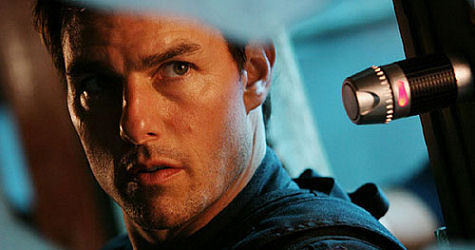
As Ethan Hunt in Mission: Impossible III (Paramount, 5.5)
And if you add this impression to some new NRG tracking numbers about Mission: Impossible III (Paramount, 5.5), you’ve got what any p.r. professional would call an issue of concern.
The NRG statistics indicate that Cruise’s box-office appeal isn’t what it used to be. The term is probably “dented” as opposed to “injured.” This allows, in any event, for a possible scenario in which M:I:3, directed and written by J.J. Abrams, may wind up with earnings that analysts will describe as “impressive,” “muscular” or “respectable” rather than “phenomenal,” “spectacular” or “record-breaking.”
There won’t be anything tragic about this. Mission: Impossible III, the first big summer film of 2006, is going to sell a shitload of tickets. I’m half into it myself, having been encouraged by what Kevin Smith said a couple of days ago (“as good if not better than the first [Mission]…Philip Seymour Hoffman plays the most believable bad guy since Anthony Hopkins in Silence“) as well as others.
And even if it’s not the greatest action movie since sliced bread, M:I:3 will still be the Big Thing to see from early to mid May until The DaVinci Code opens on 5.19.
I tried and failed to reach people who attended an exhibitor screening of M:I:3 two days ago — Wednesday, 4.12. Then I heard from a friend who said he’d spoken to two who were there. They liked it, he said, although “I didn’t get the sense that they were absolutely blown away.”
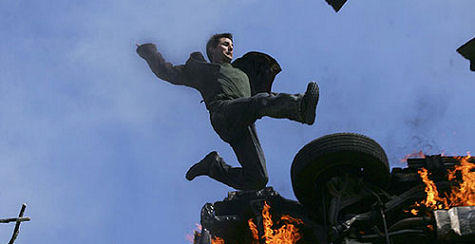
Still, if I were on Cruise’s team, I wouldn’t be feeling very good about that stupid Scary Movie 4 parody. David Zucker’s comedy earned a little over $40 million this weekend…that’s a lot of laughing kids streaming in and out…and I don’t see how those Tom Cruise wackazoid gags can do anything but mess with M:I:3‘s revenue.
There are indications all over the map that a portion of the public doesn’t believe that the 43 year-old Cruise is Tom Terrific anymore — they think he’s Tom Wacko.
I got going on this jag after hearing some National Research Group numbers that were released on Thursday, 4.13. They supposedly indicate the public’s interest in seeing Mission: Impossible: 3. I got them from a single source (I tried double- confirming with other marketing people but nobody was around due to the Good Friday holiday) but “they’re straight from the NRG report,” I was told, and “in black and white.”
Two figures got my attention: the 37% who said they’re definitely interested and the 9% who said they’re definitely not interested. My source says that at this same point before the opening of John Woo’s Mission Impossible: 2 — almost exactly six years ago — the definite interest number was in the mid 40s and that the definite non-interests were more like 2%.

Phillip Seymour Hoffman as super-baddie Owen Davian
Paramount spokespersons said the NRG figures on M:I:3 are wrong, claiming instead that the definite interests are in “the low 40s.” (When told about this, my source said, “They’re defending the company position”).
If you go by the NRG figures, there’s clearly diminished interest in M:I:3 compared to the readings for Mission: Impossible 2, and the negatives are obviously higher also.
9% definite non-interest now vs. 2% defininite non-interest then — that’s a different climate. But a Paramount spokesperson disputed the 9% definite non-interest figure, contending that it’s actually “30% lower.”
I’m not saying NRG is the end-all and be-all (their “methodology is terrible,” an industry-watcher contended today), but if the public is feeling somewhat cooler about M:I:3 than they were about the previous two Mission films (and I say “if”), it’s probably safe to assume this isn’t due to global warming.
The Paramount spokesperson reiterated that “this movie is going to make a lot of money,” that the definite interest percentage is “where it should be” at this stage, “our first choice figures are already over 10%” and that “we haven’t even started our [advertising] campaign yet.” Fine, fine.

Director J.J. Abrams, Cruise on set of Mission: Impossible III
How does the HE readership feel about this? Is the want-to-see on M:I:3 just as strong as it was with the last two? How much has the wacko-Tom factor entered into things, if at all? Or is this just some NRG-industry journalist circle-jerk issue that has nothing to do with what real people are thinking?
I for one don’t give a damn about off-screen behavior. Cruise can do double somer- saults and one-armed push-ups on every talk show he goes on and it doesn’t mat- ter. I mean, not as long as the movie he’s selling kicks ass.
So Big
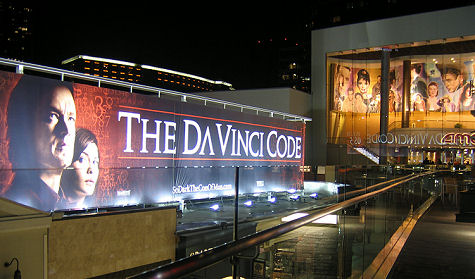
A big new AMC plex (stadium seating in all the houses) plus a big fat second-story food court opened a few weeks ago in Century City, and I finally dropped by Saturday night for a looksee. Something inside me flinches just a bit when I see an outdoor monster banner ad like this one for The DaVinci Code. It’s funny but I can feel myself inching towards feelings of vague dislike for this thing, sight unseen. No reason for this…but in the words of HAL 9000 as David Bowman was removing his memory cells, “I can feel it.”
Sensible Responses
“I’m much more excited about the third Mission than I was about the first two. Why? Because it looks like a better movie.
“And the Cruise kookiness doesn’t dissuade me in the slightest. If I didn’t boycott Val Kilmer for allegedly flicking a burning cigarette at the face of an Island of Dr. Moreau crew member (loved him since in The Salton Sea, Spartan and Kiss Kiss Bang Bang), I sure as hell am not going to lose it for Cruise because he’s passionate about something — even insanely passionate.
“The guy’s a movie star and sometime actor. If he’s an Operating Thetan 7 or whatever it is offscreen, I’m with him as long he keeps up the quality output like his work in Collateral, War of the Worlds, Magnolia and Eyes Wide Shut.” — Colin Moriarty , Canton, Ohio.
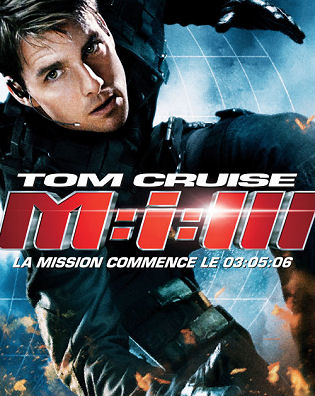
“I’m with you on how Cruise’s behavior influences my interest in seeing his movies: it doesn’t. Maybe if would if he had less of a quality track record (like Will Smith or Mel Gibson), but Cruise consistently picks interesting projects and talented directors: Kubrick, Spielberg, P.T. Anderson, Brian DePalma, Michael Mann, Cameron Crowe, etc. Devotion to Scientology can’t override that.
“Add in Mission: Impossible III having the best cast assembled in the series so far, my appreciation of J.J. Abrams’ work on TV, and both trailers so far kicking ass and getting my blood going. Put that together, and M:I:3 is actually the big May movie I’m most confident will be decent or better (because I realize my hopes for X3 may be in vain). A bit of creepy behavior from Cruise can’t change that.
“However, I fear that I may be in the minority on this. I don’t read People or Us or In Touch Weekly , but lots of people do. I know some of my co-workers have expressed a feeling of ickiness regarding Cruise in general and his new sequel in particular, and I have a feeling that the argument that Cruise has shown admirable interest in making good movies in the past won’t fly with everyone.
“In short, this is another case of the general public approaching things from a point-of-view not exactly guided by a love of movies, but rather an interest in celebrity culture and gossip. M:I:3 can probably still bank on at least $180 mil or so, but the gossip-rag backlash that was too late to really harm War of the Worlds may be in effect.” — Jesse Hassenger
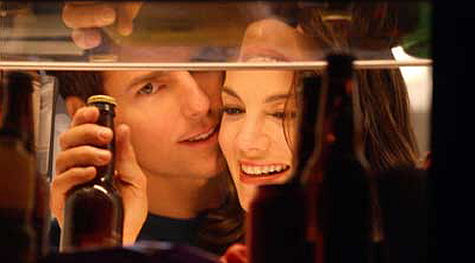
Cruise, Michelle Monagahan in Mission: Impossible III
“Who knows how big the wacko-Tom factor will play, but the solid majority of my Lost-addicted friends (college aged, guy-guys) are sold on M:I:3 based solely on writer/director J.J. Abrams. They remember the 2-hour Lost series premiere that Abrams directed, and tune in along with 20 million other viewers each week.
“And as far as I’m concerned — wacko, schmacko. Cruise usually gets the job done with intensity and control. Chef Boyardee may very well have been a nut (this is pure speculation), but dude knew how to can some delicious pasta.” — Kevin Costello
“I was contacted last night by the AC Nielsen people about upcoming films, and I responded with a ‘definitely’ about my desire to see M:I:3. I was then asked about my feelings about M:I:3 costars Tom Cruise, Ving Rhames and Keri Russell, and I said I’m in the camp of believing Cruise’s appeal isn’t what it used to be.
“I found it strange that the surveyor never inquired about the only M:I:3 participants who are solely responsible for my desire to see ot — actor Philip Seymour Hoffman and director J.J. Abrams. I would be skipping this third installment if not for the opportunity to see J.J. flex on the big screen and watch P.S.H. go bad-guy.

“I might be alone in my feelings, but I feel the best way to keep people interested in a fourth installment of this franchise would be a Dr. Lecter-like victory for Hoffman’s character over Cruise’s Agent Hunt.” — Lucas Ross, Oklahoma City, OK.
“The MI films present a conundrum. They’re just ‘movies’ vs. actual aesthetic experiences. Both of these kinds of film can use the power of film, but the desired payoff is different. The aesthetic films we expect to challenge us, nourish us, and, one hopes, maybe even make us better (I know that’s asking a lot). A movie…well, it’s a pleasant way to have a shared experience with some friends that doesn’t involve exchanging bodily fluids.
“For those of us who like a little aesthetics/intelligence with our ass-kicking, M:I:3 seesm like a disappointment in advance. For all the money spent making them, for all the flash and technology, the MI films are more than disposable — they’re forgettable.
“That said, M:I:3 does have my interest for one reason: Phillip Seymour Hoffman. You know he’ll bring it when he shows up, and that alone could put me a theatre seat.” — Roy “Griff” Griffis
“I like Tom Cruise. He’s no Paul Giamatti, but he constantly delivers in an above-average, movie-star-charisma kinda way. He’s got a certain amount of acting talent, but it’s that weird star-wattage thing that defines a Tom Cruise performance.

“Is he crazy? And does that affect the box office? Uhm, he may be a bit nutty, yeah…but quite frankly, that’s how I like my Hollywood stars. Let’s face it, Angelina Jolie was a lot more interesting when she was wearing a vial of Billy Bob Thornton’s blood around her neck.” — David S.
“The best thing Paramount can do to get me to see Mission: Impossible 3 is break my air conditioning on opening weekend.
“Otherwise, what’s unappealing to me about Cruise at this stage is not that he’s a cult member living in his own hermetic cocoon but that his control-freakishness has erased any human interest he once had back in Risky Business or even Jerry Maguire days. He’s as sleekly machine-tooled and inhuman as the T2000.
“Even when he tries to play a character part (Collateral, let’s say) he’s so erased of imperfection that he’s unrecognizable as one. His War of the Worlds character had human imperfections like a Calvin Klein model has stubble.
“Maybe the day will come when, as with Gary Cooper or Randolph Scott, age puts some character into his boyish face and he starts depicting human frailty, not superhuman relentlessness, on screen.” — Mike Gebert
Grabs

Car wash on Pico Blvd. near Beverly Glen– Thursday, 4.13, 5:20 pm.
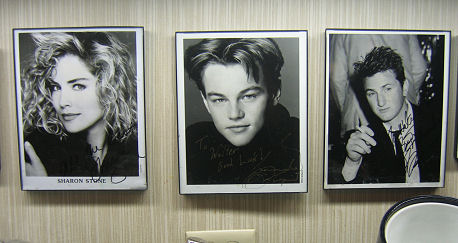
Photos hanging just above counter and near the jelly beans in the big glass jars in foyer of Sunset Screening Room — Thursday, 4.13, 9:20 pm. Photos were given in tribute to Walter, the guy who’s owned and run the room for years. Pic was taken during a late-inning recess I took from Chen Kaige’s The Promise, a flamboyant Chinese-costume adventure film — arch, bullshit-stuffed, pageantry-for-its-own-sake — that I watched for a half-hour or so but mainly slept through. I hated, hated, hated the parts that I saw.
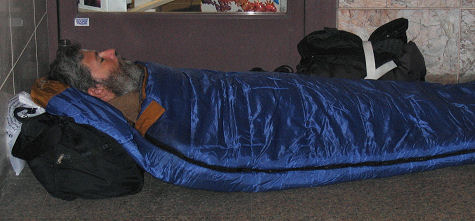
I’ve never seen a guy sleeping in front of a building with such a nice-looking sleeping bag in my life. He had a nice bag with him instead of the usual plastic garbage bag or shopping cart, and his beard was semi-trimmed and not that long. This seems to indicate he’s a semi-responsible guy who’s run into hard times and is sincerely homeless, as opposed to most of the homeless people I’ve seen, who seem to fit the general definition of “bums.” Taken on Monday, 4.10, just after the first screening of United 93
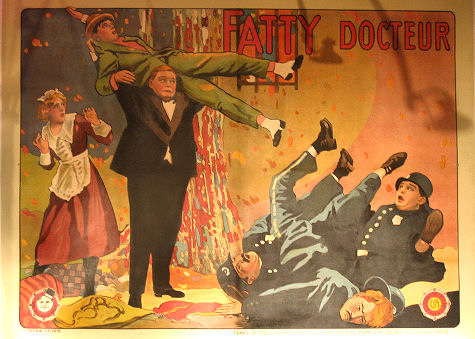
Hanging in window of a Beverly Hills store…I forget where. The French-made poster is for a 1917 Fatty Arbuckle film called Oh, Doctor!

"I think United 93 takes
“I think United 93 takes away the detachment of media reports, as well as the passage of time, and puts you directly into these situations. By doing so, the Hollywood-influenced concept of heroism that invariably exists in our mind is replaced by something more visceral and potent. Paul Greengrass is giving us a modern version of You Are There. David Poland ‘s being a contrarian and not rising up to the concept of being challenged by what is right there on the screen. He wants dramatization and fiction.” — L.A.-based director-screenwriter who saw United 93 before the press screenings started.

